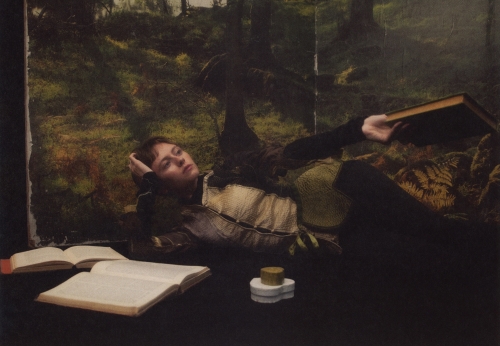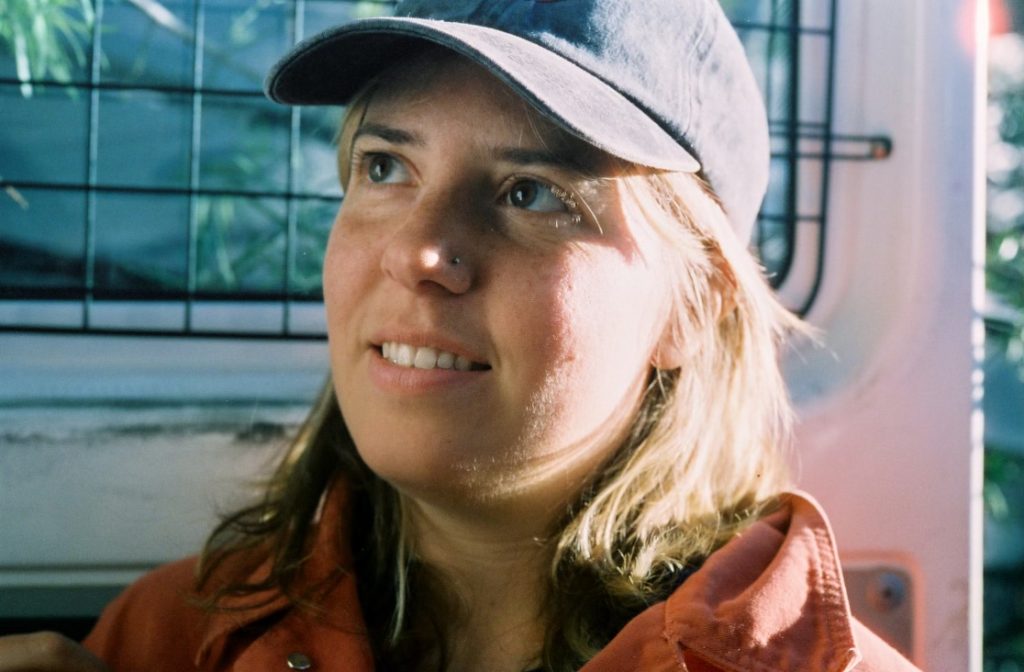
On Jellywish Florist invite listeners to question everything — to imagine a world where magic, surrealism, and the supernatural are our companions in day-to-day life. It dares to present a realm of possibility and imagination in a time that feels evermore prescriptive, limiting, and awful. The album finds Florist exploring life’s big questions without offering silver linings, morals, or definitive answers. Instead, the band asks perhaps the most difficult of questions: Is it possible to break free from our ingrained thought cycles and pedestrian way of life? That, Florist posits, may be the only way to be truly happy, fulfilled, and free.
Singer, guitarist, and principal songwriter Emily Sprague says that the record is purposely complicated. “It’s a gentle delivery of something that is really chaotic, confusing, and multifaceted,” she explains. “It has this technicolor that’s inspired by our world and also fantasy elements that we can use to escape our world.”
“We enter an observational fever dream about floating through liminal space between lifetimes, individual perceptions. There is reflection on our connectedness in joy and suffering through the wish for a peaceful place for our spirits to live and land,” Sprague explains. “‘Have Heaven’ establishes the world of the album to be not quite always lucid, but rather a perspective that is blended into the worlds of the magic and death realms swirling around us. The chorus is a chant that pleads for a better symbiosis between these worlds, and between our earthly forms trying to survive alongside each other, bound to the systems we must exist within.”
Jellywish is an exercise in multidimensional world building. The album’s panoramic cover art, which looks like something out of a Henry Darger volume, wraps the music in a collage of color that presents as science fiction-adjacent, hinting at something mysterious, fantastical, and mythological. Inside the album’s jacket, however, are tender and catchy sonic meditations on life’s most knotty subjects: life, death, earth, reality, relationships, joy, and pain. Taken together, Florist offers an acute sense of the band at this moment, one that worries about the world and its place in it. In contrast, it also presents an alternative to the doldrums of day-to-day life, and the necessary suggestion that very different things may be true at the same time.
With Jellywish, Florist offers a complex album in a time that is anything but simple. In mining the chaos and wonder of physical and spiritual worlds, the band holds a mirror to itself to the great benefit of all. It tells us that we are not alone, and challenges us to believe in magic.

Skullcrusher
Helen Ballentine’s spellbinding first full-length album Quiet the Room is the sound of a window opening, a barrier dissolving. Across these fourteen tracks, the outside world seeps in and the inside world crawls out. The result is a stunning and quietly moving work that reflects the journeys we take through the physical and spiritual realms of ourselves in order to show up for the world.
While writing the album in the summer of 2021, Ballentine drew inspiration from her childhood home in Mount Vernon, NY. What she set out to capture on Quiet the Room was not the innocence of childhood, as it is so often portrayed, but the intense complexity of it. Past and present merge Escher-like in this dreamlike space laced with elements of fantasy, magic, and mystery. Musically, this translates into a sound that feels somehow weighty and ephemeral all at once, like a time lapse of copper corroding.
To capture the effortless blend of electronic, ambient, folk, and rock, Ballentine and her collaborator Noah Weinman brought in producer Andrew Sarlo to record at Chicken Shack studio in Upstate New York, close to where Ballentine grew up. “We wanted every song to have that little twinkle, but also a sense of crumbling,” she says. These songs thrum with moments of anxiety that boil over into moments of peace, as on lead single “Whatever Fits Together,” which chugs to a ragged start before the gears catch and ease. On “It’s Like a Secret,” Ballentine struggles to connect and let people in, recognizing that no one can ever fully know our inner worlds and that to understand each other is to cross a barrier and leave a part of ourselves behind. And yet, on closing track “You are my House,” she finds a way to reach out. “You are the walls and floors of my room,” she sings in perfect, hopeful harmony.
As the album cover invites, these are dollhouse songs to which we bend a giant eye, peering into the laminate, luminous world that Ballentine has created. Like a kid constructing a shelter in a patch of sharp brambles, she reminds us that beauty and terror can exist in the same place. The complexities of childhood are so often overlooked, but through these private yet generous songs, she gives new weight to our earliest memories, widening the frame for us—even opening a window.




